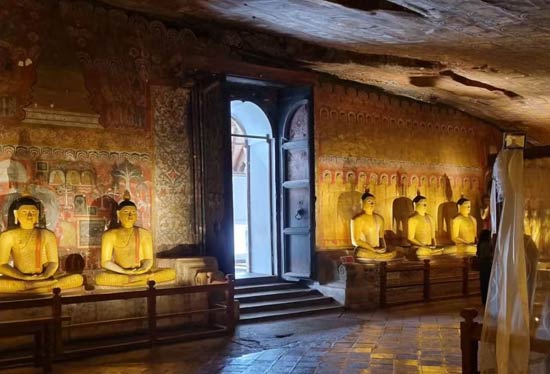A thousand miles from home: How Sri Lanka’s heritage inspires my work
The skies here are pale, the architecture is quieter, and the homes are cooler in spirit. Seasons come and go. Yet, I carry a warmth deep within me – a rhythm, a palette – inherited from the island where I was born. The cadence of life here moves faster, more distant, more efficient.
I grew up surrounded by beauty I had yet to understand: the kind forged over centuries rather than the mere seasons. It is only now, while living far away, that I realize those early experiences laid the very groundwork of who I am, not just as an interior designer, but as a human being deeply rooted in story, texture and soul.

Sacred design: lights reflect on the floor of Dambulla Cave Temple
I walked barefoot across cool terracotta floors as a child, traced floral fretwork on ancient wooden doors with my fingers, and watched sunlight filter through clay lattice windows in my school hostel. I grew up mostly in Kurunegala and Kandy, a small village near Narammala, where coconut plantations and endless paddy fields surrounded me. I visited temples carved into rock faces – spaces where you could feel the weight of silence. I didn’t know it at the time, but these experiences were shaping me. Before I ever studied design, I had already lived it.
Sri Lanka’s design heritage is more than a visual language, it is a living rhythm of light, material, craft and memory. Across centuries, our island nation has developed an aesthetic based on symbolism, storytelling and harmony with nature. From the sacred walls of temples to the woven textures of village homes, every detail reflects our culture, climate and craftsmanship. Nor is it a trend. It is a continuum — shaped by land, religions and climate. From the great stone stupas of Anuradhapura, aligned with the stars, to the stunning moonstones (sandakadapahana) carved with their rings of animals and lotuses, design was a spiritual act. Cities were designed with reservoirs (wewa), tree-lined roads, and paths of meditation, not for grandeur but for harmony.
What moved me most as I grew older was not only the beauty of these places, but their honesty. In traditional Sri Lankan design is connected to purpose, to place, to climate and most profoundly, to spirit. Clay, wood, stone and fibre weren’t merely materials — they were part of the earth, and they aged gracefully. There was no distinction between art and life; a handloom mat, a brass oil lamp, a painted ceiling – all held significance. Even a simple doorway held geometry passed down through generations.
My country’s artistic legacy is not just history — it’s living memory. One of the most exquisite examples of Sri Lanka’s sacred spatial design is found in Ridi Viharaya (the Silver Temple), nestled in the hills of Kurunegala. A blend of rock-cut architecture and timber craftsmanship, Ridi Viharaya illustrates a deep connection between sacred space and topography. The image house (vihara-ge) rests within a cave and is lavishly adorned with 18th-century Kandyan-era paintings and wood carvings featuring scenes from the Jataka tales, floral borders with stunning patterns and protective deities. What is remarkable is the way the architecture respects and accentuates the rock itself; instead of reshaping nature, it honours it. This speaks of a design philosophy where spirit and stone are not separate, but one.
No discussion of Sri Lankan heritage would be complete without honouring the Dambulla Cave Temple. I first visited Dambulla in the mid-’90s. I was young, travelling with my parents and two siblings in our sky-blue Morris Minor. This sprawling monastic complex, with its five caves and over 2,000 sq.m of mural decoration, is perhaps the total of Sri Lankan religious art. Buddhist iconography fills the walls and ceilings. It features scenes from the life of the Buddha, images of celestial deities, and geometric mandalas. All of these are painted in natural pigments on plastered stone surfaces.

Ridi Viharaya
The colour palette of Dambulla is warm and spiritual. It includes ochres, cinnabar reds, slate blues, deep black, and gilded gold leaf. These murals, which date from the 1st century BCE to the 18th century, evolved but kept a steady theme and technique. This created a living art tradition that passed down through generations of temple painters. In the ceilings of Dambulla, repeating floral motifs, lotus medallions, and rows of peaceful Buddha figures in different mudras, the rhythmic repetition creates a sacred geometry that surrounds the devotee. Here, design becomes a form of meditation.
What ties these sacred spaces to domestic architecture is the shared language of proportion, texture, and symbolism. Even the simplest village home drew from this visual vocabulary — from the placement of the hearth to the orientation of doors and sleeping quarters. Every line was drawn with intention, not merely for comfort, but for auspiciousness, community and harmony with nature.
Sri Lanka’s craft traditions were also infused with spirituality. I remember watching dumbara weavers, cross-legged on the floor, thread bold designs into cloth with plant-dyed threads. I remember the smell of raw lacquer in Matale, where craftsmen wrapped wooden grips while hand-painting red and black stripes. Masks were crafted shape of lightweight kaduru wood in Ambalangoda — blazing, radiating meaning, myth, and protection. They are not just objects — they are extensions of cultural memory.
As an interior designer working abroad now, I find myself reaching for those memories in some unexpected ways. When I design a kitchen, I remember the generous hearths of village homes. When I add a lighting plan to a design, I think about how temple lanterns flickered against gold leaf and stone. I favour natural textures over perfection, organic forms over sterile lines. These are not conscious decisions — they’re instincts, rooted in a childhood surrounded by beauty that was humble and sacred all at once.
And I realize how rare that is — and how much it has shaped me. I did not become a designer in a classroom. I became one in the slow, sensory world of home. I see every project as a storyteller instead of just an interior designer. My interest in light and shadow, my appreciation for natural textures, and my sense of symmetry and balance all began in kitchens, courtyards, temples and other spaces shaped by skilled hands back home. Design trends change frequently, but I always return to what I know: meaningful details, lively spaces and craftsmanship that holds memories. I want to respect that in my work. I aim to show that heritage is about continuity, not just the past. Understanding our history is crucial for building our future with care and clarity.
I have also come to believe that design is not separate from identity. As Sri Lankans, our national character has been shaped by art and craft as much as by language and politics. Our temples, textiles, and houses tell stories of resilience, community, and spiritual awareness. They are echoes of the way we lived before – in a deep relationship with place. So when I say I miss home, I don’t just mean family or food. I mean the sound of temple bells echoing through mango trees. I mean moonlight on a polished cement floor. I mean the quiet dignity of a handwoven mat, or the reverence carved into a wooden doorframe. I mean design that whispers, not shouts.
I know that I never left these things behind — they live in my hands. They live in the way in which I shape space, choose colour and place light. The island of my childhood may be worlds away from where I am now, but that island is inside me. It gave shape to my taste, ethics and sense of space. And it taught me that design travels through memory, material, and meaning. It traverses matter and feeling. For everything that Sri Lanka has given me, for every moonstone, mural and pattern that marked my soul, I am eternally grateful.
Searching for an ideal partner? Find your soul mate on Hitad.lk, Sri Lanka's favourite marriage proposals page. With Hitad.lk matrimonial advertisements you have access to thousands of ads from potential suitors who are looking for someone just like you.


